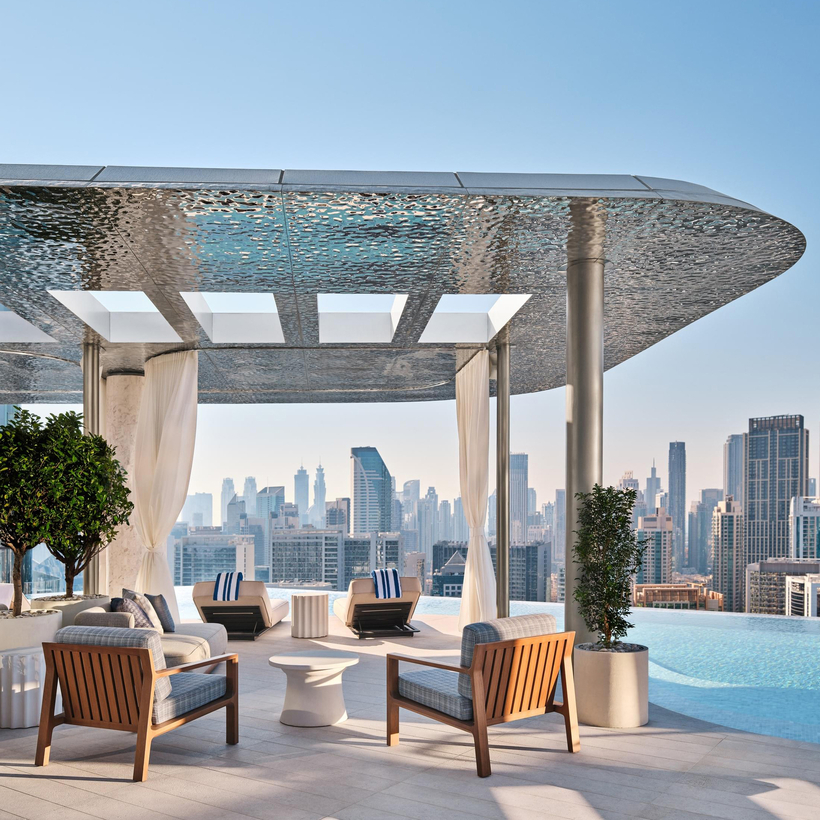On my first visit to Dubai, 15 years ago, it brought forth the maxims I learned as a child: Opulence is vulgar. Extravagance is unbecoming. Waste is shameful, and bragging, uncouth.
But that was then. During my third and most recent stay, Dubai struck me as a necessary place to visit to understand today’s world. This booming desert city serves up a spectacle that makes Las Vegas seem like a village in the Cotswolds.
Now larger than Chicago’s, Dubai’s population nearly doubled from 2010 to 2020. Around 90 percent of the city’s 3.5 million residents are now foreign-born, mostly from Lebanon, South Asia, and the Philippines. Many of them come to propel the main motors of Dubai’s economy—construction and tourism. Recently, the city has seen the arrival of more than 300,000 Russians, luxuriating in the nearly constant sunshine of this peaceful, safe place with the best tax-free shopping in the world. (One of the malls has an indoor ski slope.)

Dubai is a tale of two cities, too, with more than 68,000 resident millionaires and 15 billionaires living in a kind of luxury that’s almost alarming. A single-digit vanity plate—a public indicator of extreme wealth—recently sold for $15 million. Many restaurants liberally sprinkle gold leaf over Caesar salads and cheeseburgers, because eating the precious metal is a popular way of showing off among the city’s super-rich.
But since luxury is usually associated with rarity, what does it really mean in a place of such excess? The Dorchester Collection’s new, 225-room Lana hotel provides an elegant answer—with subtlety. Located on the Dubai Canal, it occupies a handsome, hinge-shaped, 30-story high-rise designed by London’s Foster + Partners architects.

The French interior designers Patrick Gilles and Dorothée Boissier have created a refined new version of Persian Gulf style. The soothing décor is rendered in a politely sensual color scheme of sand, cream, driftwood, desert rose, and dove gray. These shades were inspired by the natural environment of Dubai when it was still a settlement of Bedouins living in goat-hair tents.
When oil was discovered, in 1966, everything changed. In the space of a lifetime, Dubai became a 21st-century version of New York, Hong Kong, or Singapore, a crossroads of the world’s great civilizations and home to its second-busiest airport. (Dubai will soon become even busier now that the government has announced a $35 billion project to build one of the world’s largest airports, scheduled for completion in the next 10 years.)
A single-digit vanity plate—a public indicator of extreme wealth—recently sold for $15 million.
Though Dubai loves to gild the lily, Gilles and Boissier’s design discreetly suggests that luxury is about editing rather than excess. There are no gold toilets; the feel is earthy. In the guest rooms, mocha-colored wood paneling adds warmth and scale, while white marble door frames add a touch of grandeur without being ostentatious. Insets of thick, sand-colored carpeting are surrounded by bands of toast-colored stone and white marble. The furnishings—upholstered headboards, modular sofas, accent tables—are functional, not showy.

Suites are accessorized with turntables, vinyl records, and watch-winding machines. (The Dorchester Collection, owners of Le Meurice, in Paris; Hotel Eden, in Rome; the Beverly Hills Hotel, in Los Angeles; and the Dorchester, in London, among others, knows its audience.) High-tech flourishes abound, including switch-controlled lighting and curtains that don’t require a Ph.D. to operate.
Calling all swimmers: the infinity pool on the 30th floor offers spectacular views of the Burj Khalifa, the world’s tallest building, and the Lana is also building a beach club, to which boats will whisk guests from the hotel’s private marina. From doormen to housekeepers, the employees (who hail from 68 countries) are so kind and meticulous that it’s hard to believe this property opened only on February 1.

The Lana also capitalizes on Dubai’s recent reputation as a global arena for the world’s great chefs. The hotel’s most formal restaurant is Jara, from Basque chef Martín Berasategui, who has three Michelin stars at his eponymous restaurant, in Lasarte-Oria, Spain. It specializes in high-quality Spanish seafood and meats, grilled over a wood fire.
Frenchman Jean Imbert, head chef at the Hôtel Plaza Athénée in Paris (another Dorchester Collection property), delivers one of his very best culinary performances anywhere at Riviera, the Lana’s largest restaurant. It serves a superb Arabian breakfast menu, and at lunch, its gorgeous carpaccios and tartares are best enjoyed alongside the risotto. The talented pâtissier Angelo Musa supplies the excellent pastries, sandwiches, scones, and desserts that have made the Lana’s afternoon tea so popular.

(Muso’s pastries are also sold at the hotel’s Bonbon Café, a perfect place to pick up a meal for the airplane home. Perhaps the slow-roasted-beef baguette with provolone, caramelized onions, and arugula, finished with a slice of grapefruit cheesecake?)
Dubai has many extravagant places to spend a night, including the over-the-top Burj al Arab, the two Atlantis hotels (the Palm and the Royal), and the lovely One & Only. But the Lana is Dubai’s first great hotel. The Dorchester Collection managed to do here what it has already achieved in London, Paris, Rome, Milan, and Beverly Hills—create a hotel of serious sophistication, and change the world’s view of the city in the process.
Room rates at the Lana begin at $925 per night; AIR MAIL was partly hosted.
Alexander Lobrano is a Writer at Large at AIR MAIL. His latest book is the gastronomic coming-of-age story My Place at the Table: A Recipe for a Delicious Life in Paris


